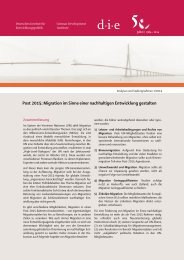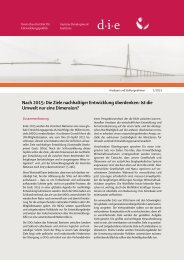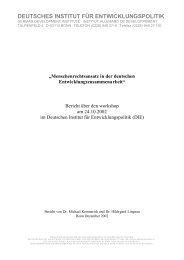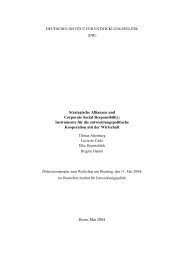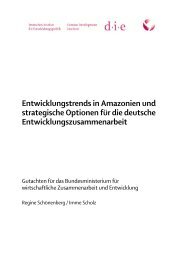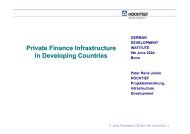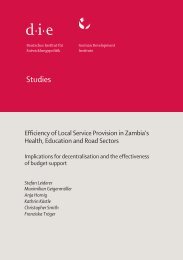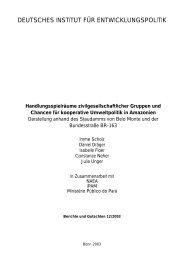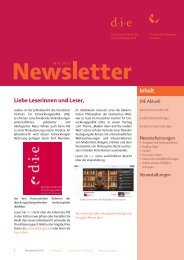Middle East / North Africa and the Millennium Development Goals ...
Middle East / North Africa and the Millennium Development Goals ...
Middle East / North Africa and the Millennium Development Goals ...
Create successful ePaper yourself
Turn your PDF publications into a flip-book with our unique Google optimized e-Paper software.
92<br />
Markus Loewe<br />
Figure 18 cont’d: Trends in <strong>the</strong> implementation of MDG8 / Target 12<br />
Source:<br />
For <strong>the</strong> indicators: see Kaufmann / Kraay / Zoido-Lobaton (1999)<br />
The date used are taken from <strong>the</strong> website of <strong>the</strong> World Bank Institute at:<br />
http://info.worldbank.org/governance/kkz2004/tables.asp (27 June 2006).<br />
Abbreviations:<br />
MENA = <strong>Middle</strong> <strong>East</strong> <strong>and</strong> <strong>North</strong> <strong>Africa</strong><br />
EAP = <strong>East</strong> Asia <strong>and</strong> Pacific<br />
EECA = <strong>East</strong>ern Europe <strong>and</strong> Central Asia<br />
LAC = Latin America <strong>and</strong> <strong>the</strong> Caribbean<br />
SA = South Asia<br />
SSA = Sub-Saharan <strong>Africa</strong><br />
Notes on <strong>the</strong> indicators:<br />
The indicators may take on values ranging from -2.5 (very poor) <strong>and</strong> +2.5 (very<br />
good). They are made up of numerous indicators from 13 different research institutions,<br />
NGOs, <strong>and</strong> commercial rating agencies (including UNDP, <strong>the</strong> World<br />
Competitiveness Yearbook, Gallup International, Freedom House, <strong>the</strong> Heritage<br />
Foundation, <strong>the</strong> Economic Intelligence Unit, <strong>and</strong> St<strong>and</strong>ard <strong>and</strong> Poor’s). The<br />
World Bank Institute staff who designed <strong>the</strong> indicators emphasize <strong>the</strong>mselves<br />
that <strong>the</strong>se indicators can be used at best to come up with trends, since <strong>the</strong> individual<br />
components are based on subjective expert assessments.<br />
Still, entrepreneurs in all Arab countries – including, e.g. Jordan – point to<br />
inefficiency <strong>and</strong> corruption in administrations, overregulated markets, a<br />
lack in <strong>the</strong> rule of law, <strong>and</strong> complicated government approval procedures<br />
as major problems with which <strong>the</strong>y have to contend – in addition to o<strong>the</strong>r<br />
factors like difficult access to capital or inadequate workforce qualification.<br />
They indicate, though, that <strong>the</strong>y have less problems with inflation,<br />
crime, infrastructure, <strong>and</strong> stability (Loewe et al. 2006; Lopez-Claros /<br />
Schwab 2005, 179 ff.).<br />
The fact that <strong>the</strong> markets in <strong>the</strong> region are anything but open, <strong>and</strong> nondiscriminatory<br />
is also evident in <strong>the</strong> low volume of foreign direct investment<br />
(FDI) flowing into <strong>the</strong> MENA countries – although, of course, numerous<br />
o<strong>the</strong>r factors of course also pay a role here. Only a fraction of global FDI<br />
goes to <strong>the</strong> MENA region (UNDP AFESD 2003, 102). In no o<strong>the</strong>r part of<br />
<strong>the</strong> world – except sub-Saharan <strong>Africa</strong> – is <strong>the</strong> volume of FDI anywhere<br />
near as low as here. In <strong>East</strong>ern Europe <strong>and</strong> Central Asia <strong>the</strong> figure amounts<br />
German <strong>Development</strong> Institute



